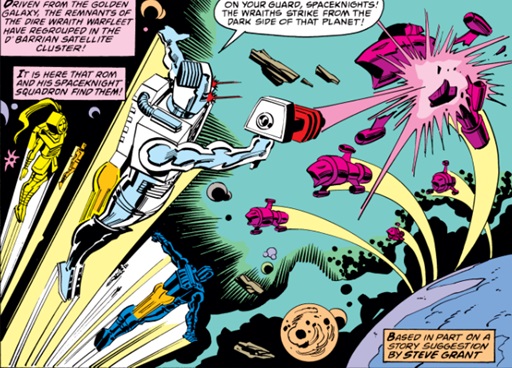 D'BARRI SECTOR /
D'BARRI SECTOR /D'BARRI SATELLITE CLUSTER
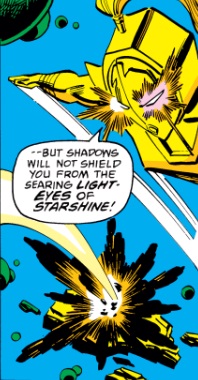
 D'BARRI SECTOR /
D'BARRI SECTOR /
D'BARRI SATELLITE CLUSTER
Official Name: D'barri Satellite Cluster and/or D'barri Sector
Location: Extraterrestrial space, unrevealed star system, unrevealed galaxy;
Population: Unrevealed
Government: Unrevealed
Major Resources: None known
Defense: Unrevealed, if any;
the Spaceknights arrived to deal with the Dire Wraiths, but that was most likely a one-time occurrence
Prominent Residents: None known
Prominent Visitors: Unidentified Dire Wraiths, Spaceknights (Rom, Starshine/Landra, Terminator, others unidentified)
First Appearance: Rom#14/2 (January, 1981)
History:
(Rom#14/2 (fb) - BTS) <200 years ago (see comments)> - Driven from the "Golden Galaxy" (see comments), the remnants of the Dire Wraith warfleet regrouped in the D'barrian Satellite Cluster.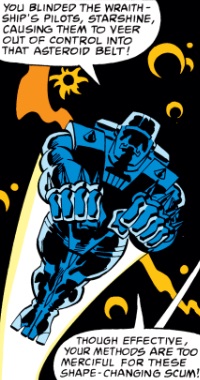
(Rom#14/2 (fb) - BTS) - It is at least speculated
(notably by the Spaceknight Terminator) that the Dire Wraiths had
regrouped in the D'barri Sector as a diversion to draw the Spaceknights
away from Agricon to facilitate their invasion of Agricon.
(Rom#14/2 (fb) - BTS) - Dire Wraiths invaded Agricon, taking control of its capital and replacing a number of its people. Rom's lover, Ray-Na, who was in residence on Agricon, was taken hostage to be used to control Rom. A distress call was either sent to the Spaceknights directly or via Galador.
(Rom#14/2 (fb)) - The Spaceknight squadron including Rom, Starshine, Terminator and at least one unidentified Spaceknight arrived in the D'barri Satellite Cluster.
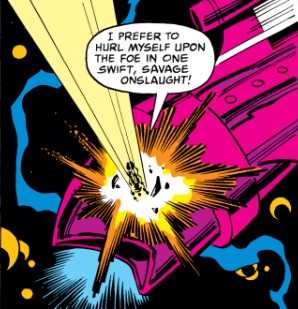 (Rom#14/2) - Rom
warned his team as the Dire Wraiths attacked from the dark side of a
nearby planet. Rom blasted a Wraith ship with his neutralizer;
Starshine blinded the pilots of another, causing it to crash into an
asteroid; Terminator smashed through the hull of a ship and used his
blacklight beams to painfully dispatch the Wraiths to Limbo or to Hell
(Rom#14/2) - Rom
warned his team as the Dire Wraiths attacked from the dark side of a
nearby planet. Rom blasted a Wraith ship with his neutralizer;
Starshine blinded the pilots of another, causing it to crash into an
asteroid; Terminator smashed through the hull of a ship and used his
blacklight beams to painfully dispatch the Wraiths to Limbo or to Hell
(Rom#14/2 (fb) - BTS) - An undetermined number of Spaceknights perished in the effort, but the Wraith warfleet was ultimately destroyed.
(Rom#14/2) - Considering the reports of the extensive Wraith activity in the D'barri Sector, Rom told his fellow Spaceknights that after they had attended to their own dead...<he presumably was going to state that they would investigate further, but he was interrupted>.
An unidentified Spaceknight
arrived and reported to Rom that a distress call had been received from
Agricon, and that the Wraiths were there.
Comments: Created by Bill Mantlo and Sal Buscema.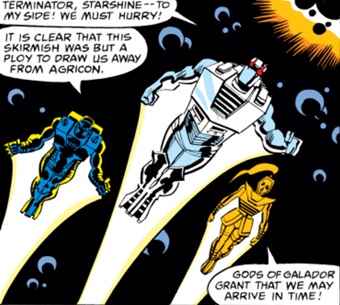
I would presume the unidentified Spaceknights who were left behind in the D'barri sector -- at least two of an unspecified number of survivors -- conducted any dealings with / burial of the dead Spaceknights and/or investigations of the remainder of the D'barri sector.
Speaking of which, the "D'barri" reference would
seem to be a misspelling of D'Bari (or D'bari), who had been recently
identified in X-Men I#135 (July, 1980), just a few months before this
story, although the "Medusa" alien later identified as Vuk had
previously appeared way back in Avengers I#4 (March, 1964). In X-Men
I#135, Dark Phoenix had destroyed the star D'bari, but that was in the
present, while the story in Rom#14/2 took place around 200 years ago.
The D'Barri Sector was apparently outside the "Golden Galaxy" (more on that below), but presumably nearby.
Regarding the names of the D'barrian Satellite
Cluster and the D'barri sector, I agree that they were probably inspired by the
star D'Bari that Dark Phoenix had destroyed in X-Men I#135 six months earlier,
but I just can't see any way it which they could reasonably be connected. After
all, D'bari was in the Shi'ar Galaxy, which is (probably) a long way away from
the Milky Way and Galador.
--Donald Campbell
"200 years ago"
The flashback in Rom#1 took place "200 years
ago," which would have been around 1780 A.D. when the story was
published in 1979.
The sliding timescale moves that date way forward,
and Rom#1 would be around 9 years before the stories currently being
published in the Marvel Universe (so like 2015 at the time this profile
was written in 2024 A.D.).
However, I would think that the date of
initial Galador-Dire Wraith conflict should stay fixed in time in the
late 18th century A.D. rather than being moved forward into the 1800s.
Or should it? Significant amounts of time have passed that having it stay fixed in time would make the initial conflict between the Wraiths and Galadorians 250 years ago, rather than 200 years ago...
The whole idea of what the "Golden
Galaxy of Galador" was and where it was located was NEVER properly
addressed in the Rom comic. Writer Bill Mantlo seemed to be unclear on the
difference between a galaxy and a star system since he also did the same thing
with the Dark Nebula, sometimes referring to it as a galaxy and sometimes as a
star system. As someone who has known the difference for as long as I can
remember, I found that quirk to be REALLY frustrating. However, if you're
looking for someplace within either the Rom comic or the Official Handbooks
that provides a reasonable explanation, then you're out of luck.
Once the comic
was canceled, Marvel never took the time to clarify what the Golden Galaxy
was. Well, except for that one caption in Infinity#1 that reads "SIXTY
THOUSAND LIGHT-YEARS AWAY. THE GOLDEN GALAXY. THE PLANET GALADOR." And,
since that's all it says, that caption could mean that the planet Galador is in
a (dwarf) galaxy that is orbiting the Milky Way galaxy about 60,000 light-years
from Earth or it could mean that the "Golden Galaxy" is the name of
the star system (or some other region of space) within the Milky Way galaxy
that is 60,000 light-years away from Earth and where Galador was located. NOT
REALLY HELPFUL, is it?
--Donald Campbell
I
am confident there will be further discussion, but when Rom attempted
to return to Galador in Rom#24, he encountered the Champions of Xandar,
who would presumably have been in the Andromeda Galaxy, where Xandar
was located.
Of course, we know
that Mentus had been moving Galador (or perhaps the entire "Golden
Galaxy") toward the Dark Nebula, but presumably Galador and the Dark
Nebula had been in relative proximity to have happened upon and warred
against each other.
And then Galactus moved Galador (or perhaps the entire "Golden Galaxy") at the end of Rom#27 (February, 1982);
The Official Handbook of the Marvel Universe I#5:
Appendix to Alien Races: Humanoid Races sub-entry (May, 1983) notes
Galador to be in the Milky Way Galaxy.
The Official Handbook of the Marvel Universe I#9: Rom entry (September, 1983) confirmed Galador to be in the Milky Way Galaxy.
The Official Handbook of the
Marvel Universe II/Deluxe Edition#11: Rom entry (October, 1986)
referenced Galactus' translocation of Galador, noting uncertainty about
Galador's past and present locations but speculating that perhaps it
had always been in the Milky Way Galaxy.
--Snood
Yes, the idea that Rom ended up in Xandar's star
system when he had Mister Fantastic program the "Skrull" saucer to
take him to Galador was the basis for Rom#24. I remember expressing my opinion
that, although everything in space is always moving relative to everything
else, the idea that Xandar and its star system could have taken the place of
Galador and its Golden Galaxy in less than 200 Earth-years was so totally
ridiculous that there had to be some other reason. My suggestion was that the
coordinates for Galador that were stored in Rom's memory banks had gotten
scrambled sometime during Rom's 200 years in space, including recent events on
Earth (like being overloaded with energy by Jack of Hearts, causing amnesia, or
when Kitty phased through him), and that that was why Rom ended up at Xandar
when he wanted to return to Galador.
Also, I have no objection to the idea that the
"Golden Galaxy" was (at most) just a name for the volume of space
within the Milky Way Galaxy that was under Galador's influence, but some of the
times when Bill Mantlo used that term were definitely in reference to a single
star system.
For example, although the idea that Mentus would
have been able to move an entire galaxy was ridiculous, the fact that Galador
had absolutely been moved suggested that (in that instance) the term
"Golden Galaxy" was being used to refer only to Galador and is star
system, including its twin suns. Galactus presumably did not include those suns
when he relocated Galador at the end of Rom#27.
When Brandy Clark arrived on the relocated
Galador in Rom#73, there first scene showed two circles in the sky, one orange
and the other smaller and yellow. Those may (or may not) have been a binary
pair of stars that Galador was now orbiting. However, later in that issue, the
two circles in the sky were seen again, but this time the yellow one was larger
than the orange one. Since only a matter of minutes separated those two scenes,
that suggests that either the two stars orbited each other incredibly fast...or
they weren't actually both stars. Weird.
Rom#75 also showed Galador having only one
orange sun in its sky, both on the cover and in the story.
In the Annihilators miniseries, Galador had a
single yellow sun which ended up being fused with Wraithworld's Black Sun.
And then, Galador's sun and the Black Sun were
no longer fused together when Galador was supposedly destroyed by the Builders
during the Infinity miniseries.
--Donald Campbell
Profile by Snood.
CLARIFICATIONS:
The D'Barri sector and/or the D'Bari satellite cluster have no KNOWN connections to:
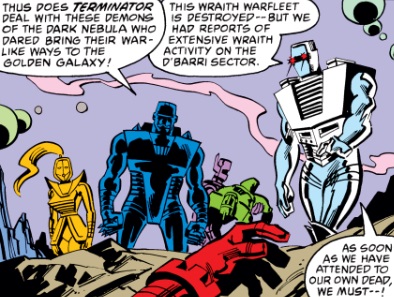 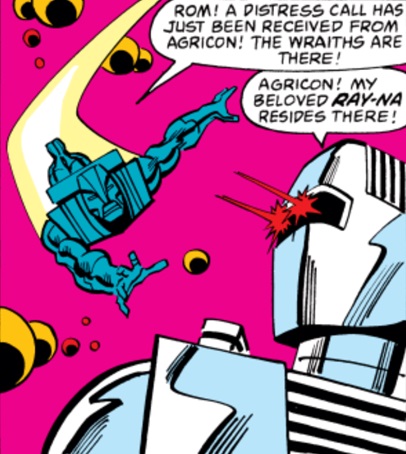 --Rom#14/2 --Rom#14/2Note: As Rom discusses matters with Starshine and Terminator in the image to the left, a Spaceknight can be seen carrying a fallen Spaceknight. Additionally, the red hand in the foreground presumably represents another fallen Spaceknight. And, to the right, we have the full image of an unidentified Spaceknight who reports the distress call from Agricon. At some point, we'll probably do a profile on the Spaceknights as a whole, and then perhaps we'll move this sub-profile there. |
images: (without ads)
Rom#14/2, pg. 1, panel 1 (Rom, Starshine & Terminator confronted by Dire Wraiths);
panel 3 (Starshine-blinded Wraiths crashing into asteroid);
panel 4 (Terminator in space);
pg. 2, panel 1 (Terminator assualting Wraith ship in space);
panel 4 (Rom, Starshine
& Terminator on planetary surface; unidentified spaceknight
carrying a fallen knight with the hand of a third in the foreground);
panel 5 (unidentified spaceknight delivering message to Rom);
panel 6 (Rom, Starshine & Terminator flying in space)
Appearances:
Rom#14/2 (January, 1981) - Bill Mantlo (writer), Sal Buscema (artist),
Jo Duffy (editor); based in part on a story suggestion by Steve Grant
Official Handbook of the Marvel Universe I#5 (May, 1983) - Mark Gruenwald (editor/head writer/designer), Michael Carlin (associate editor/designer), Peter Sanderson, Mark Lerer, Roger Stern, Tom DeFalco (writers), David Cody Weiss, Bob Simpson, Joanne Harris, Peter David (researchers), Eliott R Brown (technical advisor), Josef Rubinstein (inker)
Official Handbook of the Marvel Universe I#9 (September, 1983) - Mark Gruenwald (editor/head writer/designer), Michael Carlin (associate editor/designer), Peter Sanderson, Mark Lerer, Dan Fingeroth (writers), Fred Baumann, Joanne Harris (research team), Eliott R Brown (technical advisor), Josef Rubinstein (inker)
Official Handbook of
the Marvel Universe II (Deluxe Edition) #11 (October,
1986) - Mark Gruenwald (writer/producer), Steve Saffel, Peter Sanderson (writers/researchers), Elliot R. Brown (technical illustrator), Josef Rubinstein (inker), Marc Siry, Harry Eisenstein, David Wohl (editorial assistants), Howard Mackie (assistant editor)
First posted: 12/01/2023
Last updated: 12/02/2023
Any Additions/Corrections? please let me know.
Non-Marvel
Copyright info
All other characters mentioned or pictured are ™ and ©
1941-2099 Marvel Characters, Inc. All Rights Reserved. If you like this stuff,
you should check out the real thing!
Please visit The Marvel Official Site at:
http://www.marvel.com
Special Thanks to www.g-mart.com for hosting the Appendix, Master List, etc.!